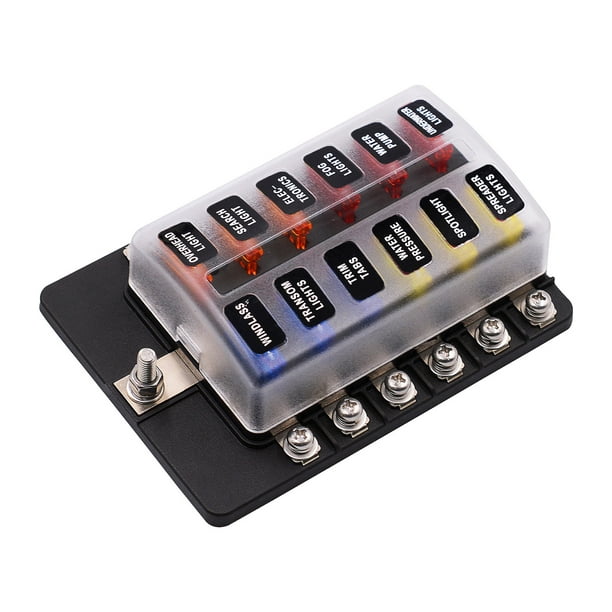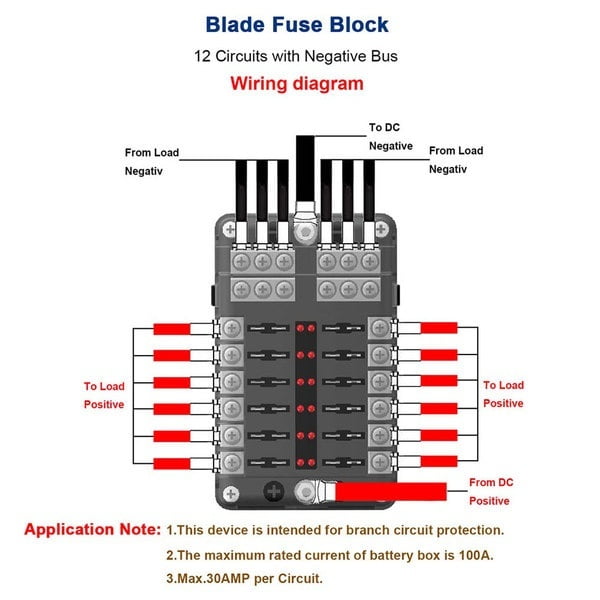All About Blue Sea Fuse Block
Wiki Article
Some Known Facts About Blue Sea Fuse Block.
Table of ContentsBlue Sea Fuse Block for DummiesThe Basic Principles Of Blue Sea Fuse Block All about Blue Sea Fuse BlockTop Guidelines Of Blue Sea Fuse BlockSee This Report about Blue Sea Fuse BlockBlue Sea Fuse Block - The Facts
Fuses are bolted in place between the bus bar and the second set of electrically isolated screws. With this installation you can attach the watercraft's numerous high-current circuits, such as a windlass, bow thruster, high-output generator, the DC panel, and so on, to the separated bolts. The different merges are sized according to the current-carrying ability of the conductors bolted to them.Some circuits will still need to bypass the isolation switch to ensure that they may be left on when the remainder of the watercraft is closed down. blue sea fuse block. These circuits generally include a bilge pump and any kind of billing tools (consisting of photovoltaic panels, perhaps a wind generator, as well as the inverter if it additionally functions as a battery charger).
This becomes part of the circuit diagram we developed for the facility instance boat in our Boat Electrics program. The gadgets attached to the fuse block in the top right are all bypassing the seclusion button S1. If you sign up for Watercraft Electrics 101, you will certainly discover how to review such a layout and also just how to make one for your own boat.
The Blue Sea Fuse Block PDFs

With DC circuits, the OCP is always put in the favorable side of DC circuits. Keep in mind that some European boatbuilders install integrates and also battery buttons in the DC adverse side and also on the favorable side, yet this is not recommended except in some isolated (floating) ground DC systems.
This factor might be at the battery, the battery switch, the circulation panel, a subsidiary panel, some circulation bus bar, or other connecting factor. If the conductors in the brand-new circuit are no smaller than the conductor that feeds the brand-new circuit's factor of link, then the OCP for the feeder conductor will sufficiently protect the brand-new circuit - blue sea fuse block.
The 4-Minute Rule for Blue Sea Fuse Block
If the new circuit is not adequately offered by overcurrent gadgets currently in location, added protection is called for at its point of connection, i. e., at its resource of power. Placement of merges in the favorable conductor. Note exactly how a smaller sized fuse is utilized every single time a smaller conductor is linked, Sometimes area restricts how close an OCP gadget can be positioned to the resource of power.The common response, from the ABYC, is within 7" (17. The ABYC enables the following, which have been tightened up in recent years: A conductor connected directly to a battery that is likewise "consisted of throughout its whole range in a sheath or room such as a channel, joint box, control box or encased panel" need to have its overcurrent defense "as close as achievable to the battery, yet not to go beyond 72 inches click here for info (1.
Gone is the covering 72" allocation that made use of to be there. A conductor attached to a resource of power various other than the battery (e. g., the battery switch, the distribution panel, or some other point in the DC circuits) that is similarly included in a sheath, etc, must have its overcurrent protection "as close as achievable to the factor of link to the source of power, however not to exceed 40 inches (1.
Blue Sea Fuse Block for Beginners
Provided that alternators themselves are a source of check out this site power, it has actually been arguable whether these included alternators needed OCP at the alternator itself."Cranking-motor circuits are not needed to have overcurrent defense.In the aquatic area, where cranking circuits may be long, this technique might produce a hazard. If an automobile catches fire, the passengers can draw over and leap out. If a watercraft captures fire, it is not so straightforward. It makes no sense to have any type of vulnerable circuits on a watercraft.
In winter, the inrush existing on a 12V starter motor may be as high as 1,500 amps; the cranking current might be as high as 200 find out this here amps. Typically, cranking conductors are undersized also for the cranking existing, let alone the inrush existing. This scenario does not pose a security issue in itself, due to the fact that these currents are suffered for only a few secs, so the conductors do not have time to fume adequate to create a fire risk.
All about Blue Sea Fuse Block
If you wish to discover just how to wire a boat, step-by-step in 56 video lessons, take a look at our Watercraft Electrics 101 training course. We made the program with absolute beginners in mind. As the electrical lots on watercrafts boosts, so too does the complexity of electric circuits and also the capacity for short circuits and electric fires.
In the aquatic field, where cranking circuits may be long, this technique might produce a danger. If a vehicle ignites, the occupants can pull over as well as jump out. If a watercraft catches fire, it is not so basic. It makes no feeling to have any vulnerable circuits on a watercraft.
Some Known Questions About Blue Sea Fuse Block.

If you intend to find out exactly how to wire a boat, detailed in 56 video lessons, look into our Watercraft Electrics 101 program. We made the course with outright beginners in mind. As the electric tons on boats rises, so as well does the complexity of electric circuits and also the potential for brief circuits and electric fires.
Report this wiki page